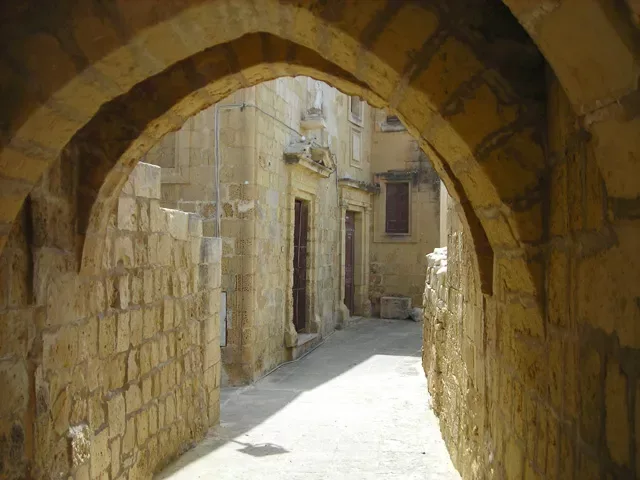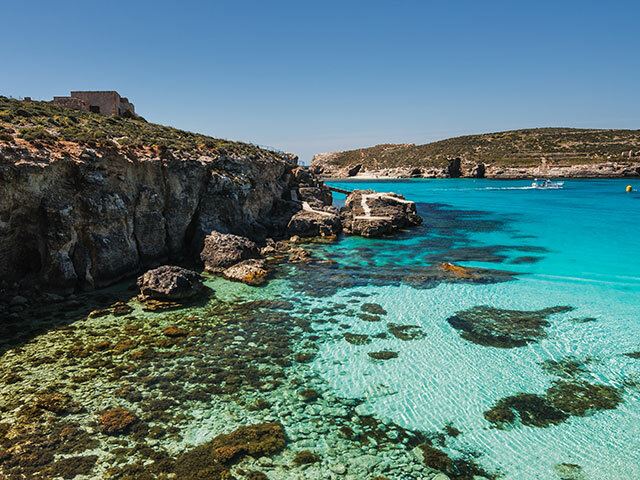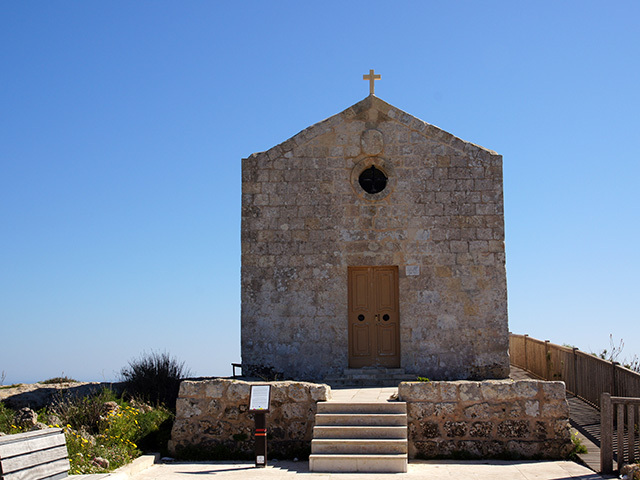
Journey to mysterious Malta to experience a land rich in tradition with Finbarr Ross. Finbarr is a mystic and facilitator of self-realization through awakened consciousness, the Ascension process, the feminine principle, the divine feminine, the second coming, the threefold golden flame, Mary Magdalene and the Grail legends.
Malta is a very beautiful green-carpeted land, with blue skies and surrounded by crystal-clear azure seas. Feel the energy of the Island of Dreams and see the honey-colored temples of Malta which were built on amazing sites as a powerful celebration to the abundance of the Mother. Malta is known as the island of honey and the island of beautiful temples, with underground chambers and sculptures that show us that they were dedicated to the goddess. We will explore some of the best-preserved temples from six thousand years ago – Hal Saflieni Hypogeum, Tarxien, Mnajdra, Hagar Qim and Ggantija. The beautiful, small islands of Malta and Gozo still have dozens of these Neolithic sacred sites, all of which predate Newgrange, Stonehenge and the Pyramids. We will have a beautiful opportunity to explore these amazing ancient sites and make a conscious connection with their amazing energies of the goddess.
Malta, in its history, has been occupied by Sicilians, Phoenicians, Carthaginians, Romans, Arabs, Normans, Knights of St. John, Napoleon, and the British. It has a very rich diverse cultural heritage with many churches as well as ancient temples.
In this amazing place of beauty which holds so much ancient wisdom, be prepared for a transformational journey as your heart opens and you become consciously aware of this as we experience the energies of each ancient temple.
Malta Arrival: You will be greeted at the airport and transferred to our hotel. Welcome drinks and dinner as the group gets to know one another at our hotel.
(D)
This morning we'll begin our Sacred Journey to Malta and Sicily with a visit to the sacred sites of Valletta: Barrakka Gardens, the Archaeological Museum (we’ll take special note of the Sleeping Lady of Malta and the Fat Ladies of Hagar Qim), and St. John's Co-Cathedral. Lunch on our own. Ferry trip to Sliema and minibus back to hotel.
We'll explore the National Museum of Archaeology, a Maltese museum of prehistoric artifacts that is managed by Heritage Malta. The ground floor of the museum exhibits prehistoric artifacts from the Maltese islands from the Ghar Dalam phase (5200 BCE), the earliest appearance of settlement on the island, up to the Tarxien phase (2500 BCE).

We'll visit St John’s Co-Cathedral, a gem of Baroque art and architecture. It was built for the Knights of St John. The Grand Masters and several knights donated gifts of high artistic value and made enormous contributions to enrich it with only the greatest works of art. The origins of the Order, which is known as the Knights Hospitaller of Saint John of Jerusalem, of Rhodes, and of Malta, date back to around 1050. The Cathedral contains eight amazing chapels, each dedicated to a patron saint.
In the late afternoon, we'll visit the sacred site of Bugibba. We renamed this temple Dar ir-Risq u l-Gid – The House of Wealth and Prosperity. Lunch with soft drinks or water in a local restaurant.
(B, L & D with wine)

Today on our Sacred Journey to Malta and Sicily, we explore the old capital of Malta, called Mdina (the city of Nobles), and the suburb of Rabat. We will visit the Mosta Dome. The history of Mdina traces back more than 4,000 years. It is a medieval walled town connected to Malta's Phoenician settlers. According to tradition, it was here that in 60 A.D. St. Paul is said to have lived after being shipwrecked on the Islands. Furthermore, it is said that St. Paul resided inside the grotto known as Fuori le Mura (outside the city walls) now known as St. Paul's Grotto in Rabat.

Lamp lit by night and referred to as "the silent city," Mdina is known for its timeless atmosphere as well as its cultural and religious treasures. Mdina has had different names and titles depending on its rulers and its role but its medieval name describes it as - ‘Citta' Notabile' - the noble city.
Next, we'll visit the Mosta Dome, the third largest unsupported dome in the world with its beautiful decoration and wonderful energy, dedicated to the Assumption which is celebrated on August 15th. It is also known as the Rotunda of St Marija Assunta. Then, back to the hotel for dinner and overnight.
(B & D with wine)

Today on our Sacred Journey to Malta and Sicily we will enjoy a full day trip to Gozo by ferry. First, we visit Ta Pinu Sanctuary, then the Cittadella. We will spend a full day on Gozo visiting Goddess temples!
Our first stop is the Ggantija (gii-gan-tii-ya) Prehistoric Temples in Xaghra (sha-ra). The Ggantija temples here are the earliest of a series of megalithic temples. The ancient builders erected the two Ggantija temples during the Neolithic Age (c. 3600-2500 BCE), which makes the temples more than 5500 years old and some of the world's oldest. According to local Gozitan folklore, giants built these temples and used them as places of worship. There is a belief that there was an oracle here, just as there was at the much-later Temple of Apollo at Delphi. In ancient times, the temples dedicated to the Mother Goddess at Ggantija are said to have drawn pilgrims from across the island, and from North Africa and Sicily.

From here, we travel to Dwejra to see the Azure Window, Fungus Rock and the Inland Sea. The Azure Window at the end of the cliff is a giant doorway through which one can admire the blue expanse beyond the cliff. It must be one of the most photographed vistas of the Islands, and is particularly spectacular during the winter, when waves crash high inside the arch. The sea around is very deep and of a dark blue hue, thus giving it the name the Azure Window. In front of the Azure Window is the Blue Hole, and The Chimney, two of the most popular dive sites in Gozo.

After lunch, we'll visit the medieval part of the city of Victoria – The Citadel, a historic fortified city or castle. The area is known to have been first fortified during the Bronze Age c. 1500 BCE. It was later developed by the Phoenicians and again by the Romans when it became the complex Acropolis. Within its walls lies a fine 17th century baroque Cathedral designed by Lorenzo Gafà, the Maltese architect who also built the Cathedral of Medina. There is a belief that it stands on the site where a Roman temple dedicated to Juno once stood. It is most famous for the remarkable trompe l'oeil painting on its ceiling, which depicts the interior of a dome that was never built. In the late afternoon we return to Mgarr Harbor and board the ferryboat to return to Malta for dinner and overnight.
Lunch in a local restaurant with soft drink or water.
(B, L & D with wine)

Today we experience the temple of Hagar Qim (ha-jah-een), and the Mother Goddess. Located on a hilltop overlooking the sea and the islet of Filfla, it is the best-preserved ancient limestone temple in Malta. It dates from the Ggantija phase, which is about 3600 to 3200 BCE. Unlike most other Maltese temples, it is a single temple, rather than a complex of two or three. Other temple ruins stand a few feet away from the main temple.
(B & D with wine)

Today we celebrate the Festival of Wesak with a full moon ceremony. We visit the world-famous and very ancient underground "dreaming" temple called the Hypogeum. The Hypogeru (or underground cavity), carved from solid rock, is a unique temple. Three stories deep, it contains rock-cut features such as a 'speaking chamber', trilithons, lintelled-doorways, a large cistern and a 'holy of holies' surrounded by 'embryonic' chambers. The Hypogeum is one of the amazing remaining structures from prehistory.

Next, we visit the Tarxien (tar-she-en) Temples, which date from 3600-2500 BCE. The temples are renowned for the detail of their carvings, which include altars and screens decorated with spiral designs and other patterns. The spiral is the most common design in megalithic art on Malta.

We experience the Comino, named after the cumin seed that once flourished in the Maltese islands. The Comino is noted for its tranquility and isolation, and for the Blue Lagoon. After going into the “underworld” of the Hypogeum, we bathe in the healing waters of the lagoon.
(B, L & D with wine)

May 22nd - Sunday - Day 7:
Today we visit the Dingli Cliffs and the Chapel of Mary Magdalene, with an amazing experience offering spectacular views.
Rock-cut tombs dating back to Phoenician, Carthaginian and Roman times have been found in the limits of Dingli. Roman baths were also found at Għajn.

At the Chapel of Mary Magdalene we will take time for meditation and through ceremony connect with her energy. Lunch at Bobbyland, a local restaurant with endless views.
In the afternoon, we begin the second half of our Sacred Journey to Malta and Sicily, honoring the Mother Goddess as we take a ferry from Malta to Sicily, crossing the Malta Straights in the Mediterranean Sea to the port of Pozzallo.
Sicily is the crossroads of ancient and modern civilizations, honoring the divine feminine for 3,000 years with their temples, black maddonas and churches. Our senses will be delighted with magnificent vistas atop sacred mountains, marvel at architecture with Arab, Norman and European roots, and enjoy delicious food with fresh ingredients reflecting the mixed cultures that make Sicily magnificent.
Upon arrival in Sicily, we travel to Syracuse where we will have a Welcome to Sicily dinner with wine, and where we will overnight.
(B, L & D with wine)

This morning we depart for Agrigento, with an en route stop in Enna, in the center of Sicily. Enna began as a Greek province, followed by Carthaginian then Roman occupation. For a brief time, it became an Arab territory.
After a visit of the city center, we'll continue on to Agrigento. In the afternoon, our Sacred Journey to Malta and Sicily continues as we explore the 5th century Valle dei Templi. We'll view another Virgin Mary and Child in the 16th century Church of Santa Maria dei Graci built over a 5th century temple dedicated to Athena - the Temple of Concord - the best preserved Doric Greek temple outside of Athens.
As part of the 7 temple complex in Agrigento, we'll also see the temple dedicated to Hera (Juno) or Demeter which faces east; the other temples are dedicated to Heracles, Caster and Pollux and Zeus.
Finally, we'll check in at our hotel in Agrigento for overnight.
(B & D)

In the morning, we'll drive to Palermo via Trapani, which was a Carthaginian town always linked to the sea. The salt marshes, now protected as a natural reserve, a historic site where salt was produced and is still of economic importance today.

In Trapani, we view the Madonna di Trapani in the Santuario di Maria Santissima Annunizata, which is a 13th century Carmelite church with its original portal and Rose window. Nearby, The Chiesa del Purgatorio has 18th century wooden statues which are venerated on Good Friday.
In the evening we will check in at our hotel in Palermo, where we will stay for the next 3 nights.
(B & D)

View our current Malta and Sicily sacred journeys: